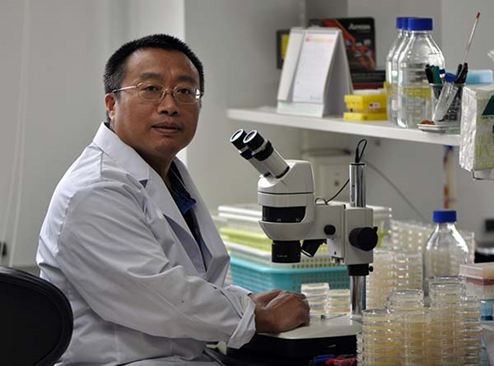Interim results of four BPAN research projects published
The NBIA Disorders Association, our sister organization in the USA, reports in its Fall Newsletter on the progress made so far in four research projects on beta propeller protein-associated neurodegeneration (BPAN). BPAN, one of the most common NBIA diseases, is caused by mutations in the WDR 45 gene on the X chromosome. Much of BPAN research focuses on the role of autophagy in the pathogenesis of the disease and as a starting point for potential therapies. Autophagy is a process in which damaged cell components such as proteins are recycled within the cell and waste materials are disposed of. This intracellular recycling and waste disposal process could be defective in BPAN and thus trigger the cascade of iron accumulation and neurodegeneration. The role of iron in BPAN is also being examined more closely in some of the studies. Each of the projects received a grant from the NBIA Disorders Association. We summarize the most important points below:
Dutch research team investigates the effects of gene mutations on patients
In 2018, Dr. Mario Mauthe (see picture) received a $45,000 grant from the NBIA Disorders Association for a BPAN project. His research team at the University of Groningen in the Netherlands is investigating what causes iron accumulation in BPAN and how iron affects the symptoms of the disease.
The scientists first investigated whether a WDR45 mutation causes the interruption of the cellular process of autophagy. They wondered whether impaired autophagy could explain the iron accumulation observed in the brains of BPAN patients.
The team observed that a loss of the WDR45 gene does not interrupt the natural process of autophagy, but that mutant cells have defects in the mitochondria, the energy-producing organelles in the cells. Since other NBIA patients also have mitochondrial defects, this could be a common feature of various NBIA diseases.
Mauthe's team is investigating whether the defective gene shows problems with mitochondrial autophagy. Further research is needed to support their hypothesis and to understand why this defect occurs and whether its treatment would be a useful route to future therapies.
Research group in London discovers potential drug candidates for the treatment of BPAN
Robin Ketteler (see picture), Professor of Translational Cell Biology at University College London (UCL), received a grant from the NBIA Disorders Association in 2019. He is an expert in the discovery of compounds with drug potential. His team used innovative screening technologies to test thousands of small molecule compounds to see which could restore autophagy in a BPAN neuronal cell model.
The BPAN cell model used had been developed by UCL colleagues Professor Manju Kurian and Dr. Apostolos Papandreou since 2014 in a precursor project also funded by the NBIA Disorders Association. Using state-of-the-art technical methods, they examined it to identify differences to healthy cells and found abnormal amounts of genes and proteins in the BPAN neurons that play a role in iron metabolism.
In collaboration with Kurian and Papandreou, Ketteler's research group has now been able to identify several molecules during drug screening that were able to improve autophagy and are now being considered for the next stage of testing. Some of these compounds have already been approved by the US Food and Drug Administration (FDA) as drugs for use in other diseases.
The next steps are to ensure that these molecules can also act in the more complex environment of the brain and reach the brain regions that need the most support. To this end, Ketteler's research group plans to develop tissue models of BPAN using three-dimensional cell models. Ketteler is currently seeking additional funding to continue this research.
BPAN research shows how iron accumulates in the brain
In September 2018, the NBIA Disorders Association awarded its first grant of 150,000 dollars to Dr. Young-Ah Seo (see picture), Assistant Professor of Nutritional Biochemistry at the University of Michigan in Ann Arbor, to support young scientists. The two-year fellowship was due to expire in August 2020, but will be extended by 12 months due to a break in research during the COVID-19 pandemic.
Seo is investigating how a mutation in the WDR45 gene leads to iron accumulation and cell damage in people with BPAN. Her team has succeeded in generating a cell model of BPAN in which the WDR45 gene is deleted. Using this cell line, the team was able to determine that the loss of WDR45 leads to significant changes in the cellular processes that regulate iron, resulting in iron accumulation in the cell model. This produces toxic unstable molecules, so-called oxygen radicals, which react easily and thus cause oxidative stress and cell damage in the cell model.
In summary, the results to date suggest that defective iron regulation in BPAN patients could be the reason for iron accumulation in the brain. Iron accumulation, in turn, leads to oxidative stress and cell damage, likely contributing to the neurodegeneration observed in BPAN patients. Seo's team is looking for molecular targets to reduce iron levels in the cell model. Once the project is completed, it could point to potential therapies for BPAN.
Study opens up new ways to understand and treat BPAN
A recently completed BPAN study led by Dr. Hong Zhang (pictured) has led to a new understanding of how a genetic defect causes BPAN and how it might be corrected. Zhang is a visiting professor at the University of Massachusetts Medical School and a researcher at the Institute of Biophysics at the Chinese Academy of Sciences in Beijing. He and his team are now working on a treatment strategy for BPAN based on the study results.
The project was sponsored by the NBIA Disorders Association and the University of Pennsylvania, which organizes an annual charity bike race for rare diseases and doubles the amount raised per patient organization. In 2017 and 2018, more than $102,000 was raised for BPAN research, which was awarded to Dr. Zhang. The first publications from the project are already available.
Zhang and his team also focused on identifying the causes of neuronal damage in BPAN. They identified a disruption of autophagy caused by a mutation in the WDR45 gene and protein. Zhang generated mouse models with a deactivated (knockout) or missing Wdr45 gene in the central nervous system. The team also studied a closely related gene, WDR45b, which causes another neurological disease associated with mental retardation. These mice performed poorly in learning and memory tests.
Zhang and his team made an important observation about the defective autophagy process. In normal cells, the waste products in the cell are wrapped in a small pouch called an autophagosome. The autophagosome then transports the waste through the cell to another pouch called the lysosome. There, the autophagosome fuses with the lysosome and the waste is then broken down and recycled.
However, in the nerve cells that lacked the WDR45 and WDR45b proteins, Zhang's team found that although the waste products were taken up by the autophagosomes, the autophagosomes were unable to connect with the lysosomes for unloading and recycling. To remedy this dysfunction, the researchers attempted to bypass the site of interference. They found that by inhibiting the modification of another protein, O-GlcNAcyclation of SNAP29, they were able to reverse the autophagy defects in cells with WDR45/45B mutation. Zhang believes that this finding shows a promising avenue for treatment.
The preparation of this summary was supported by translations from www.DeepL.com/Translator (free version) is supported.




